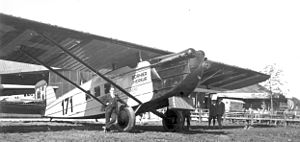Dornier Mercury
| Dornier Mercury | |
|---|---|
 Dornier Merkur of the Ad Astra Aero |
|
| Type: | single-engine airliner |
| Design country: | |
| Manufacturer: | |
| First flight: |
February 10, 1925 |
| Number of pieces: |
50 |

The Dornier Merkur (internal designation Do B-Bal ) was a single-engine passenger aircraft from German production. The high-decker , a further development of the Komet III , was built by the Dornier works in Friedrichshafen .
history
The Dornier Merkur is based directly on the Dornier Komet III, whose main weak point was the low engine power. This was due to the restrictions of the Versailles Peace Treaty . The Dornier Komet III (registration number D-815) served as the prototype, in which the BMW VI, which is much more powerful than the Rolls-Royce Eagle and with a takeoff power of 600 hp, was installed. Due to the higher engine weight and the greater power, reinforcements on the cell were necessary. Instead of the forehead cooler, an abdominal cooler was used. The four-legged supporting structure of the shoulder wing was similar to that of the comet, but received an incision on the wing's trailing edge in the area of the fuselage. The cell could accommodate six passengers in an enclosed space and two crew members in the open cockpit . The chassis was fixed and had a grinding spur.
The first flight took place on February 10, 1925.
On June 24 and 29, 1926, a machine with Walter Mittelholzer and Georg Zinsmaier as pilots set seven world records , for example by covering the 7,000 km long route Friedrichshafen - Berlin - Königsberg - Moscow - Tbilisi - Baku - Charkow without incident.
Mittelholzer had a Merkur equipped with swimmers for an expedition to Africa. The fuselage received a lounge and a bedroom for the four-person crew as well as a darkroom. The machine, named “Switzerland”, took off from Zurich on December 17, 1926. After 78 days and a total flight distance of 20,000 km (flight time: 97.5 hours), the machine landed in Cape Town on February 20, 1927 .
Machines that were equipped with a BMW VI U (with reduction gear) were given the designation Merkur II. The take-off power rose to 750 hp and the flight weight could be increased to 4100 kg, which required additional reinforcements. This also affected the struts of the wing.
One machine (registration number D-1087) was experimentally given a Junkers L-55 with an output of 650 hp. Due to the increased weight compared to the BMW VI, this combination was unsatisfactory, so the engine was removed again.
Some Dornier Merkur II were given closed cockpits, which, however, restricted the view of the pilots.
In 1927 Lufthansa opened a flight connection with Merkur via the Hindu Kush from Tashkent to Kabul and flew the first regular night connection from Berlin to Königsberg. The main purchaser of this machine was Lufthansa , with 30 units , but DERULUFT (German-Russian Air Transport Company) also used the Merkur on the route to Moscow.
A total of 50 Merkur machines were built, many of which were also flown in Bolivia , Brazil , Chile , Japan , Colombia (use with swimmers at SCADTA ), Switzerland and the USSR . A license was built in Japan.
Technical specifications
| Parameter | Data |
|---|---|
| crew | 2 |
| Passengers | 6-8 |
| length | 12.80 m |
| span | 19.60 m |
| height | 3.80 m |
| Wing area | 62.00 m² |
| Empty mass | 2280 kg |
| Max. Takeoff mass | 3700 kg |
| Cruising speed | 175 km / h |
| Summit height | 5200 m |
| Range | 1000 km |
| Engines | 1 × BMW VI ; 680 PS (500 kW) |
Received aircraft
On May 19, 2009 Lufthansa Technik AG presented the Dornier Foundation with a replica of the serial number 88/1927 (D-1103), which can now be viewed in the Dornier Museum in Friedrichshafen .
See also
literature
- Rolf Berger 1000 aircraft: Dornier Do B. NGV ISBN 3-625-10373-7 .
- Wolfgang Wagner German air traffic - the pioneering years 1919–1925. Bernard & Graefe Verlag, ISBN 3-7637-5274-9 .
- Dornier - A documentation on the history of Dornier. Dornier GmbH, 1983.
- Dornier Foundation for Aviation and Space Travel (Ed.): Dornier. Plant history and aircraft types . Delius Klasing, Bielefeld 2009, ISBN 978-3-7688-2610-5 .
Web links
- http://www.luftfahrtgeschichte.com/merkur.htm
- http://www.aviastar.org/air/germany/dorn_merkur.php (English)
- http://www.histaviation.com/Dornier_Merkur.html (English)
Individual evidence
- ^ Peter W. Cohausz: Exhibition highlight ready . In: Flugzeug Classic . No. 8 , 2009, ISSN 1617-0725 , p. 12 .

